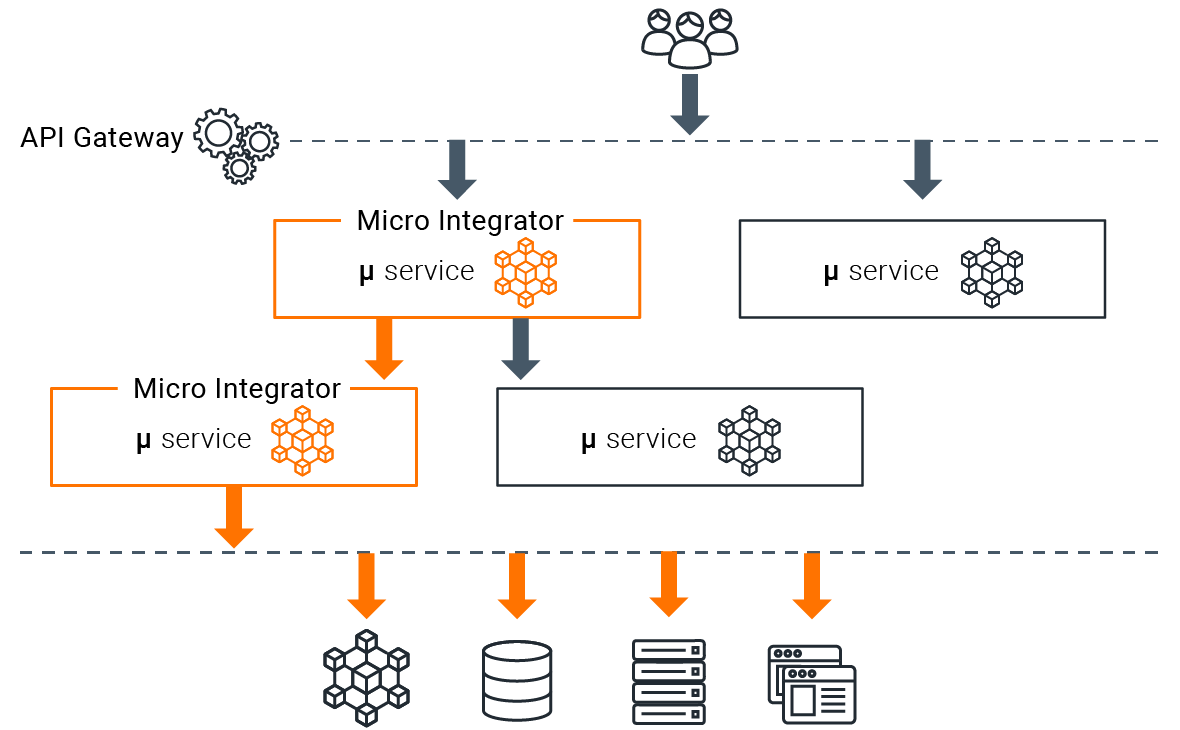Integration Overview¶
WSO2 API Manager 4.1.0 is shipped with an integration runtime (Micro Integrator) with comprehensive enterprise integration capabilities. Therefore, you can now use WSO2 API Manager to develop complex integration services and expose them as managed APIs in an API marketplace. This allows you to enable API-led connectivity across your business using a single platform.
Get Started with Integration¶
Let's get started with the integration capabilities and concepts of the Micro Integrator of WSO2 API Manager.
Quick Start with Integration
Try out a simple message mediation using the Micro Integrator.
Develop your First Integration
Build a simple integration scenario using WSO2 Integration Studio.
Key Concepts of Integration
Explore the key concepts used by the Micro Integrator.
Integration Strategy¶
You can now leverage the integration capabilities as well as the API management capabilities of the product to implement any of the following integration strategies.
API-led Integration¶
WSO2 API Manager consists of an API management layer as well as an integration layer, which enables API-led integration through a single platform. The integration layer (Micro Integrator) is used for running the integration APIs, which are developed using WSO2 Integration Studio. The API management layer is used for converting the integration APIs into experience APIs and making them discoverable to developers.
See API-led Integration for more information.
Microservices Integration¶
The Micro Integrator is lightweight and container friendly. This allows you to leverage the comprehensive enterprise messaging capabilities of the Micro Integrator in your decentralized, cloud-native integrations.

If your organization is running on a decentralized, cloud-native, integration architecture where microservices are used for integrating the various APIs, events, and systems, the Micro Integrator can easily function as your Integration microservices and API microservices.
Centralized Integration (Enterprise Service Bus)¶
At the heart of the Micro Integrator server is an event-driven, standards-based messaging engine (the Bus). This ESB supports message routing, message transformations, and other types of messaging use cases. If your organization uses an API-driven, centralized, integration architecture, the Micro Integrator can be used as the central integration layer that implements the message mediation logic connecting all the systems, data, events, APIs, etc. in your integration ecosystem.

Learn Integration¶
See the topics in the following sections for details and instructions.
Integration Use Cases¶
Learn about the main integration capabilities of the Micro Integrator of WSO2 API Manager. You can also follow the tutorials on each of these use cases to gain hands-on knowledge.
Message Routing
Explore how messages are routed to different endpoints.
Message Transformation
Explore how messages are transformed into different formats.
Data Integration
Explore how data from various sources are used during message mediation.
File Processing
Explore how data from file systems are moved and used during message mediation.
SaaS and B2B Connectivity
Explore how to integrate with third-party systems using WSO2 connectors.
Service Orchestration
Explore how multiple Restful services are exposed as a single course-grained service.
Enterprise Messaging
Explore asynchronous messaging patterns using message brokers.
Scheduled Integration Processes
Explore how integration processes are scheduled and executed periodically.
Protocol Switching
Explore how message protocols are changed during message mediation.
Integration Development¶
Learn how to set up the development environment and build integration solutions.
Quick Tour - WSO2 Integration Studio
Get an overview of the developer tool that you will use for developing integrations.
Install WSO2 Integration Studio
Install and set up WSO2 Integration Studio.
Development Workflow
Get an overview of the integration development workflow.
See the Developing Integrations section in the left-hand navigator for more topics on working with integrations.
Management and Observability¶
Learn about the dashboards, tools, and solutions that are available for managing and monitoring integrations deployed in the Micro Integrator.
Micro Integrator Dashboard
Dashboard for monitoring integration artifacts in a Micro Integrator cluster.
APICTL (CLI for Integration)
Command-line tool for monitoring integration artifacts in a Micro Integrator instance.
Observability for Integrations
Observability solution for integrations deployed in a Micro Integrator cluster.
DevOps and Administration¶
Learn how to set up a Micro Integrator deployment and configure the deployment according to your requirements.
Installation
Install the Micro Integrator in your environment.
Deployment
Select a deployment strategy and set up a deployment (on containers or VMs).
Upgrade
Upgrade to the latest Micro Integrator from previous product versions.
Configuration and Set up
Configure Security, Data Stores, Perfomance, Message Brokers, Transports, etc.
User Management
Configure a user store and manage users and roles in the Micro Integrator.
CICD Pipelines
Implement CICD pipelines for your deployment (on containers or VMs).
Integration Tutorials¶
Learn how to implement various integration use cases, deploy them in the Micro Integrator, and test them locally.
-
API-led Integration tutorials
Exposing an Integration Service as a Managed API Exposing an Integration SOAP Service as a Managed API -
Message mediation tutorials


